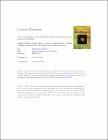| dc.contributor.author | RAMASWAMI, MANI | en |
| dc.date.accessioned | 2010-03-04T17:55:53Z | |
| dc.date.available | 2010-03-04T17:55:53Z | |
| dc.date.issued | 2010 | en |
| dc.date.submitted | 2010 | en |
| dc.identifier.citation | Amanda Freeman, Mallory Bowers, Alysia Vrailas Mortimer, Christina Timmerman, Stephanie Roux, Mani Ramaswami and Subhabrata Sanyal, A new genetic model of activity-induced Ras signaling dependent pre-synaptic plasticity in Drosophila, Brain Research, 1326 , 2010, 15-29 | en |
| dc.identifier.other | Y | en |
| dc.identifier.uri | http://hdl.handle.net/2262/38787 | |
| dc.description | PUBLISHED | en |
| dc.description.abstract | Techniques to induce activity-dependent neuronal plasticity in vivo allow the underlying signaling pathways to be studied in their biological context. Here, we demonstrate activity-induced plasticity at neuromuscular synapses of Drosophila double mutant for comatose (an NSF mutant) and Kum (a SERCA mutant), and present an analysis of the underlying signaling pathways. comt; Kum (CK) double mutants exhibit increased locomotor activity under normal culture conditions, concomitant with a larger neuromuscular junction synapse and stably elevated evoked transmitter release. The observed enhancements of synaptic size and transmitter release in CK mutants are completely abrogated by: a) reduced activity of motor neurons; b) attenuation of the Ras/ERK signaling cascade; or c) inhibition of the transcription factors Fos and CREB. all of which restrict synaptic properties to near wild type levels. Together, these results document neural activity-dependent plasticity of motor synapses in CK animals that requires Ras/ERK signaling and normal transcriptional activity of Fos and CREB. Further, novel in vivo reporters of neuronal Ras activation and Fos transcription also confirm increased signaling through a Ras/AP-1 pathway in motor neurons of CK animals, consistent with results from our genetic experiments. Thus, this study: a) provides a robust system in which to study activity-induced synaptic plasticity in vivo; b) establishes a causal link between neural activity, Ras signaling, transcriptional regulation and pre-synaptic plasticity in glutamatergic motor neurons of Drosophila larvae; and c) presents novel, genetically encoded reporters for Ras and AP-1 dependent signaling pathways in Drosophila. | en |
| dc.description.sponsorship | This work, initiated via NIDA grants DA15495 and DA17749 to MR, was supported by an NIH T32 post-doctoral training grant and grants from the URC, Emory University and a NARSAD Young Investigator Fellowship to SS, the FIRST fellowship to AF and an SFI Investigator grant to MR from the Science Foundation of Ireland. | |
| dc.format.extent | 15-29 | en |
| dc.language.iso | en | en |
| dc.relation.ispartofseries | Brain Research | en |
| dc.relation.ispartofseries | 1326 | en |
| dc.rights | Y | en |
| dc.subject | Drosophila | en |
| dc.subject | Neuron | en |
| dc.subject | Plasticity | en |
| dc.subject | Ras | en |
| dc.title | A new genetic model of activity-induced Ras signaling dependent pre-synaptic plasticity in Drosophila | en |
| dc.type | Journal Article | en |
| dc.type.supercollection | scholarly_publications | en |
| dc.type.supercollection | refereed_publications | en |
| dc.identifier.peoplefinderurl | http://people.tcd.ie/ramaswam | en |
| dc.identifier.rssinternalid | 64308 | en |
| dc.subject.TCDTheme | Genes & Society | en |
| dc.identifier.rssuri | http://dx.doi.org/10.1016/j.brainres.2010.02.061 | en |
| dc.contributor.sponsor | Science Foundation Ireland (SFI) | en |




